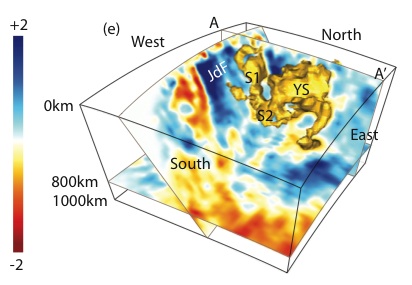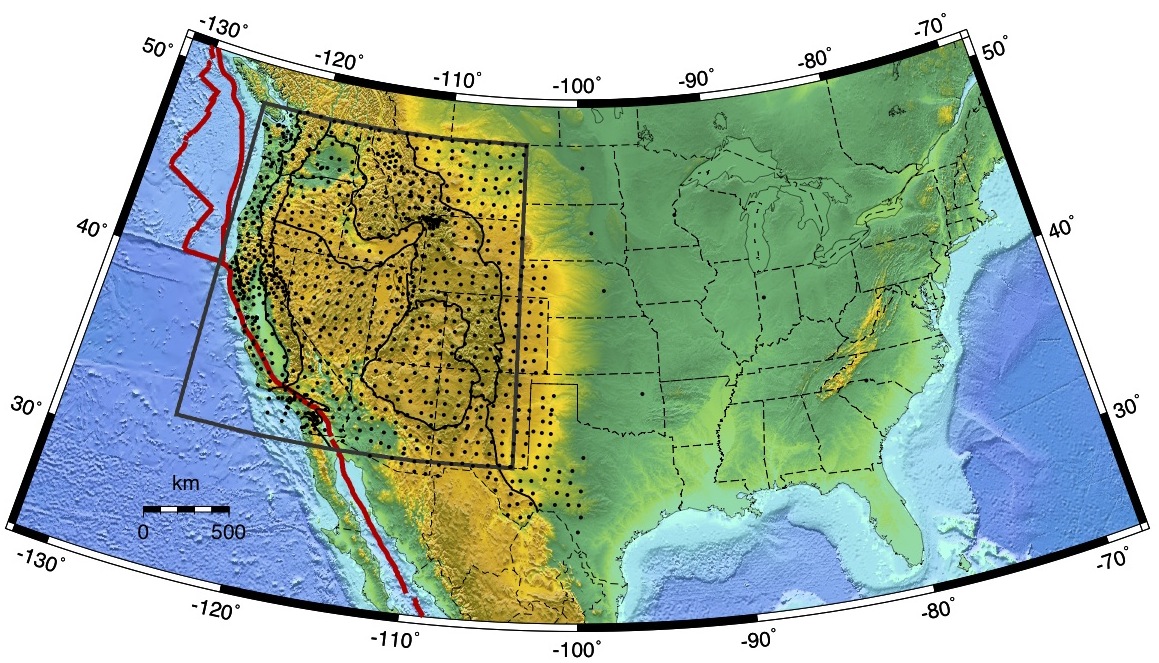|
 Model highlights:
These are the first DNA models that use finite frequency sensitivity kernels and the region of good resolution extends from the Pacific coast to east of he Rocky Mountain Front.
The P- and S-velocity models show a plume extending from the lower mantle to the surface beneath Yellowstone, and a shallow and fragmented Juan de Fuca slab.
The complex geometry is interpreted as being due to interactions between the plume and slab and can explain the unusual characteristics of the Cascadia subduction system including the absence of deep earthquakes and trench-perpendicular orientation of seismic anisotropy.
Model highlights:
These are the first DNA models that use finite frequency sensitivity kernels and the region of good resolution extends from the Pacific coast to east of he Rocky Mountain Front.
The P- and S-velocity models show a plume extending from the lower mantle to the surface beneath Yellowstone, and a shallow and fragmented Juan de Fuca slab.
The complex geometry is interpreted as being due to interactions between the plume and slab and can explain the unusual characteristics of the Cascadia subduction system including the absence of deep earthquakes and trench-perpendicular orientation of seismic anisotropy.
DOWNLOAD THE MODEL
Model specifications:
- Parameters:
DNA09-P and DNA09-S are P- and S-velocity models
- Coverage:
Good resolution extends from the Pacific coast to beyond the Rocky Mountains (~105 deg W), from the Mexican boarder (31 deg N) to the Canadian boarder (49 deg N).
- Data source:
More than 1000 stations where used from the USArray transportable array, regional seismic networks, and temporary seismic deployments.
- Data type:
Relative traveltimes of teleseismic body waves (P, S and SKS) are used to constrain the model from about 100 earthquakes.
- Inversion:
Finite frequency sensitivity kernels are used in a damped (but not smoothed) LSQR inversion.
- Resolution:
The model can resolve mantle structure to a depth of ~1000 km and with a lateral and vertical resolution of ~200km.
 Publication
Publication
Obrebski, M., R.M. Allen, M. Xue, S.-H. Hung.
Slab-Plume Interaction beneath the Pacific Northwest
Geophys. Res. Lett. 37 L14305, doi:10.1029/2010GL043489, 2010
download
Abstract
The Pacific Northwest has undergone complex plate reorganization and intense tectono-volcanic activity to the east during the Cenozoic (last 65 Ma). Here we show new high-resolution tomographic images obtained using shear and compressional data from the ongoing USArray deployment that demonstrate first that there is a continuous, whole-mantle plume beneath the Yellowstone Snake River Plain (YSRP) and second, that the subducting Juan de Fuca (JdF) slab is fragmented and even absent beneath Oregon. The analysis of the geometry of our tomographic models suggests that the arrival and emplacement of the large Yellowstone plume had a substantial impact on the nearby Cascadia subduction zone, promoting the tearing and weakening of the JdF slab. This interpretation also explains several intriguing geophysical properties of the Cascadia trench that contrast with most other subduction zones, such as the absence of deep seismicity and the trench-normal fast direction of mantle anisotropy.
The DNA09 velocity models are available for download and slicing at
http://dna.berkeley.edu
.
|

